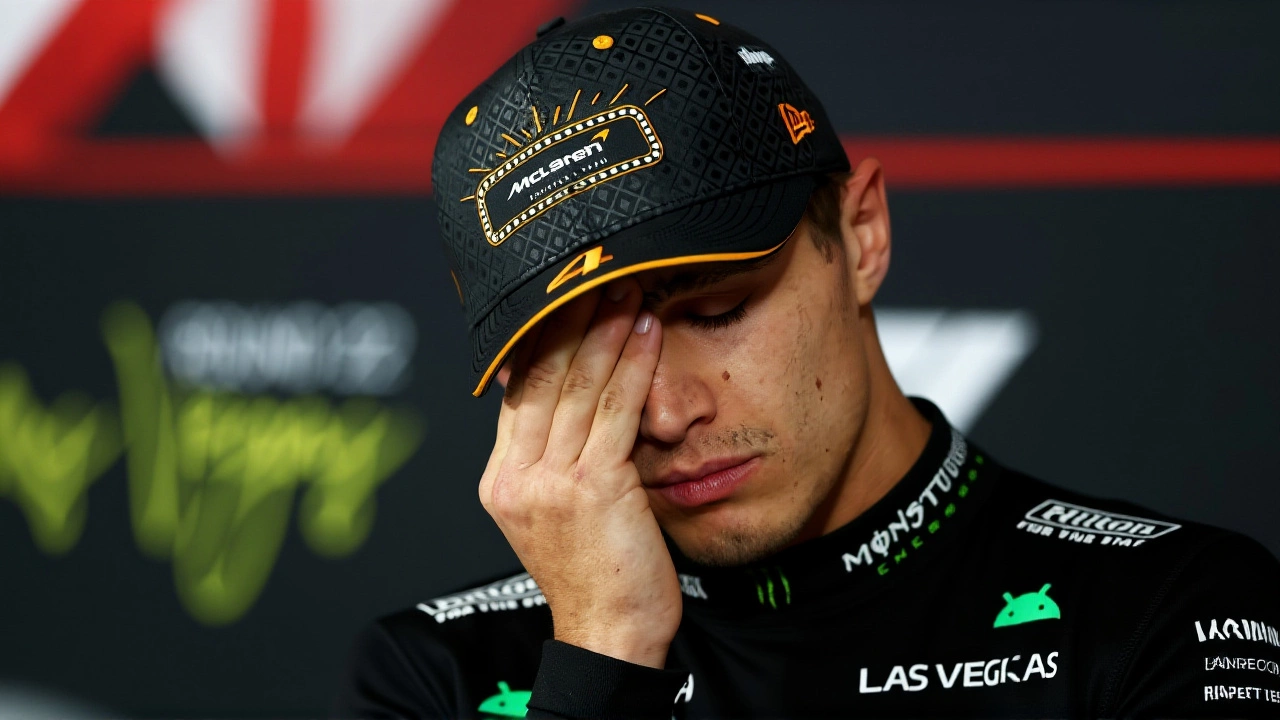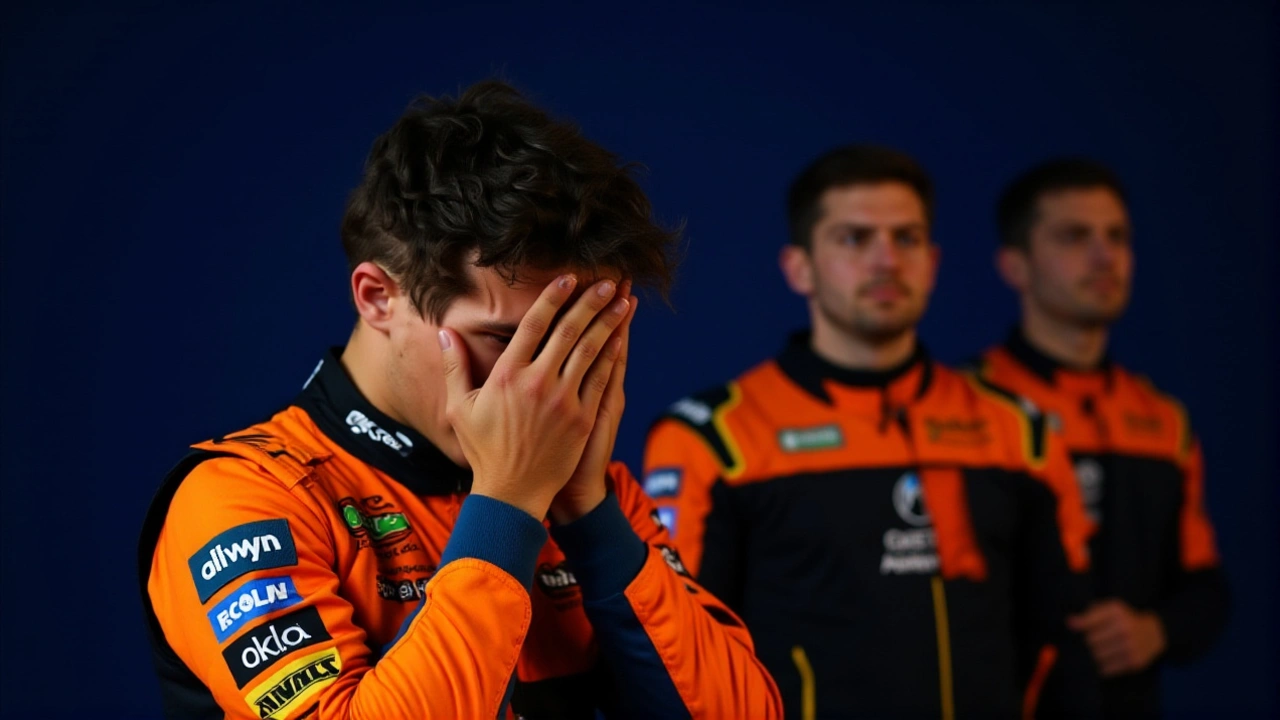Just three hours after crossing the finish line in second place, Lando Norris learned his result had vanished — along with 18 championship points. The same fate befell his teammate, Oscar Piastri, who’d finished fourth. Both McLaren F1 Team cars were disqualified from the 2025 Las Vegas Grand PrixLas Vegas Strip Circuit on Sunday night after FIA inspectors found the skid plank on each car worn below the legal 9mm minimum. The decision, confirmed at 8:35 PM Pacific Time, turned a dominant race day into a championship crisis.
What Went Wrong Under the Cars?
The issue wasn’t a broken part or an illegal wing. It was something hidden beneath the chassis: the plank. A 10mm-thick wooden composite strip mounted under every F1 car, the plank is a safety device designed to ensure cars don’t ride too low — a dangerous condition that can cause loss of control or catastrophic aerodynamic failure. By regulation, it must wear no more than 1mm per race. At Las Vegas Strip Circuit, both McLaren MCL39s had worn down to 8.7mm and 8.5mm respectively — just fractions of a millimeter beyond the limit. In F1, that’s enough to erase a podium.Team Principal Andrea Stella admitted the team had pushed the envelope. They ran a low ride height — similar to Mercedes’ 2024 setup — to maximize downforce on the concrete-heavy, high-speed corners of the Strip. But they didn’t account for how the dry race conditions on November 23 would amplify porpoising, a violent up-and-down motion caused by airflow collapse under the car. During wet practice on November 21-22, the issue was barely noticeable. Come race day? The car bounced like a skipping stone.
Why This Isn’t Just Bad Luck
This isn’t the first time a team’s gamble on aerodynamics backfired. On March 24, 2025, Lewis Hamilton lost his Chinese Grand Prix result for a 0.5mm plank violation. But here’s the twist: the FIA didn’t punish McLaren for intent. In Official Document #47, stewards explicitly noted there was “no deliberate attempt to circumvent the regulations.” They called it an “unintentional breach.”That doesn’t matter.
Modern F1 operates on zero tolerance. The rules don’t care if you didn’t mean to break them. They care if you broke them. As Niels Wittich, the FIA Race Director, put it in his post-race briefing: “Technical compliance isn’t negotiable. We don’t reward effort. We enforce the rules.”
McLaren’s error was trusting simulations. Their wind tunnel and CFD models predicted wear patterns based on wet track data. But dry asphalt in Las Vegas — harder, rougher, and hotter than expected — created friction levels they hadn’t modeled. “We thought we’d be safe,” said one senior engineer, speaking off-record. “We weren’t.”

Championship Chaos: From Comfortable Lead to Three-Way Battle
Before the race, Norris led the Drivers’ Championship with a 30-point advantage over Piastri and Verstappen. After the DQ? He’s down to 24. And Verstappen, who won the race, is now breathing down his neck.With only two races left — the Qatar Grand PrixLusail International Circuit on November 30, and the Abu Dhabi Grand PrixYas Marina Circuit on December 7 — 58 points remain up for grabs. Qatar’s sprint race format adds even more: 8 points for a sprint win, 7 for second, down to 1 for eighth. A single bad qualifying could swing the title.
“It’s not over,” Norris said in his statement. “But we’ve made it harder. We know that.”
For Piastri, the DQ is a cruel twist. He was running fourth — a solid haul — when the penalty dropped him to 14th in the standings. He’s now tied with Verstappen, just 24 points behind Norris. The team apologized to both drivers early Monday morning, calling the outcome “devastating.”
What This Means for the Rest of the Season
McLaren’s misstep has forced every team to re-examine their own ride-height strategies. Teams like Red Bull and Mercedes, who’ve also been running low, are now reviewing their plank wear data from every session. “We’re going to be measuring every centimeter of that plank after every run,” said one senior Mercedes strategist. “This isn’t just about speed anymore. It’s about survival.”Analysts at ESPN Motorsport, including senior reporter Gary Anderson, note that 2025 has seen a sharp uptick in plank violations — up 40% from 2024. The reason? Ground effect aerodynamics have become so aggressive that teams are running the car closer to the track than ever. The FIA’s response? Tighter inspections, more frequent plank checks, and zero mercy.
For McLaren, the fallout extends beyond points. Their reputation for technical precision — once a selling point for sponsors like Oracle — is now under scrutiny. With two races left, they can’t afford another mistake.

What’s Next?
The team will appeal the decision, but experts say it’s unlikely to succeed. The FIA’s technical regulations are unambiguous. Even if the breach was unintentional, the penalty is automatic.McLaren’s focus now shifts to Qatar. They’ll likely raise the ride height slightly, sacrificing downforce for safety. But in F1, every millimeter costs speed. The question isn’t whether they can catch Verstappen — it’s whether they can stop him from catching Norris.
And that’s the real tragedy here. Norris didn’t lose the race. He lost control of his destiny.
Frequently Asked Questions
Why does the plank have to be 9mm minimum? Isn’t that just a formality?
The plank isn’t a formality — it’s a safety lifeline. If a car rides too low, its aerodynamic floor can touch the track, causing sudden loss of downforce and potential crashes. The 9mm rule ensures cars maintain a minimum clearance, even after wear. FIA tests show cars below this threshold become unstable at speeds over 180 mph — exactly the conditions seen in Las Vegas. This isn’t about fairness; it’s about preventing catastrophic failure.
Could McLaren have avoided this if they’d run higher ride height?
Possibly. But in 2025, every team is chasing downforce, and lower ride height is the quickest way to gain it. McLaren chose to mimic Mercedes’ high-downforce 2024 setup, which worked in Spa but failed under Las Vegas’ concrete surface. Raising the car even 2mm would’ve cost them 0.3 seconds per lap — enough to drop them from pole to mid-pack. They gambled on simulation data and lost.
How does this affect McLaren’s chances in the Constructors’ Championship?
It’s a major blow. McLaren was leading the Constructors’ standings by 17 points before Las Vegas. After the DQ, they’re now tied with Red Bull at 428 points, with Mercedes just 8 behind. With only 58 points left, a single misstep — or another technical penalty — could cost them the title. They need both cars to finish in the top three in Qatar and Abu Dhabi to stay ahead.
Why didn’t the team notice the wear during the race?
Because they didn’t expect it. Telemetry showed no unusual vibrations during the race, and the porpoising was erratic — not constant. Teams monitor wear via post-race scans, not live data. The FIA uses laser scans on the plank after the checkered flag, not before. McLaren assumed their simulations were accurate. They weren’t. The wear happened in real time, under conditions they hadn’t tested.
Is this the end of Norris’s championship hopes?
No — but it’s the most dangerous turn yet. Norris still leads by 24 points, and he’s proven he can win under pressure. But Verstappen has won five of the last seven races and thrives in high-stakes scenarios. With Qatar’s sprint race offering extra points, one bad qualifying could erase Norris’s advantage. He’s not out — but he’s no longer in control.
What’s the likelihood of another plank violation before the season ends?
High. Teams are still pushing ride heights to the limit, especially on high-speed circuits like Qatar and Abu Dhabi. With only two races left, teams will prioritize speed over wear management. Expect at least one more DQ before December 7. The FIA has made it clear: if you break the plank rule, you’re out. No warnings. No second chances.
